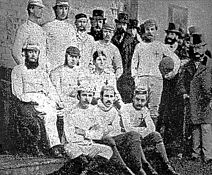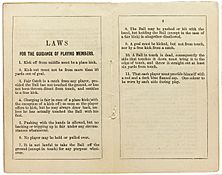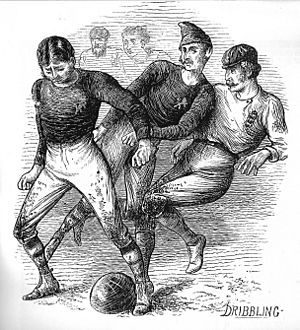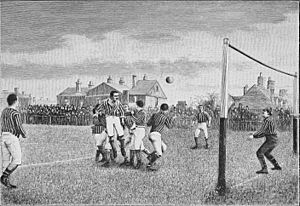History of association football facts for kids
The history of association football, known to many as football or soccer, goes back a long time, even to medieval times. Some early versions of the game might have been played in ancient Greece and Rome. Similar games were also popular in ancient China and Japan. In Britain, football-like games have been played since at least the 700s.
The modern game of association football grew from these old ball games and from games played in English public schools. The game we know today started in the mid-1800s. English football clubs worked together to create standard rules. This led to the creation of The Football Association (The FA) in London, England, in 1863. They also published the first official Laws of the Game that same year. These rules helped clubs play against each other without arguments. They also banned rough practices like kicking players' shins (called hacking) and handling the ball (except for goalkeepers). After a few meetings, association football and the game played by Rugby School rules (which became rugby football) went their separate ways.
Besides its own competitions, football has also been an Olympic sport since the 1900 Summer Olympic Games in Paris, France.
Contents
How Modern Football Rules Began
In the early to mid-1800s, different schools, universities, and clubs started writing down their own rules for football. The Rugby School was one of the first to publish its rules in 1845.
At the University of Cambridge in 1846, some students tried to create a common game and form a club. They wanted rules that everyone could agree on, especially students from different schools like Eton, Winchester, and Shrewsbury. These "Cambridge Rules" were an important step. They aimed to create a shared set of laws for football that many people would accept. These rules were changed several times, and a new set was made in 1848.
During the 1850s, many football clubs started up outside of schools and universities. These clubs often made their own rules. A famous example is the Sheffield Rules, created by the Sheffield Football Club in 1857. These rules were later adopted by the Sheffield Football Association in 1867.
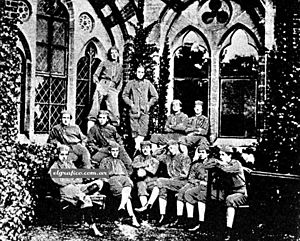
In the early 1860s, there were many efforts in England to combine all the different football games into one set of rules. In 1862, J. C. Thring, who helped create the original Cambridge Rules, wrote his own rules called "The Simplest Game". In October 1863, a new set of "Cambridge Rules" was put together by a committee of former students from several famous schools.
Ebenezer Cobb Morley, a lawyer, suggested creating a governing body for football in 1863. Morley became the first secretary of The FA and later its second president. He is best known for writing the first Laws of the Game at his home in Barnes, London. These laws are still used around the world today. Because of this, he is often called the father of the Football Association and of Association Football itself.
Schools like Charterhouse and Westminster School were important in shaping the new rules. Students at these schools often played football in small, enclosed areas. This made the rough, handling game played at other schools impossible. Instead, they preferred a passing game. When the rules for Association Football were being created in the 1860s, representatives from Charterhouse and Westminster pushed for rules that allowed forward passing. Other schools, like Eton and Harrow, preferred a dribbling game with a strict offside rule. By 1867, The Football Association chose the Charterhouse and Westminster style of play, adopting a "loose" offside rule that allowed forward passing.
On October 26, 1863, representatives from several football clubs in the London area met at the Freemasons' Tavern. This was the first meeting of The Football Association (FA). It was the world's first official football body. Six meetings of the FA were held between October and December 1863.
Rules That Were Changed
After the third meeting, The FA published a draft set of rules. However, at the fourth meeting, people looked at the recently published Cambridge Rules of 1863. The Cambridge rules were different from The FA's draft rules in two main ways: running with the ball and hacking (kicking opposing players in the shins).
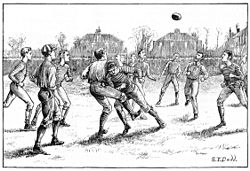
At the fifth meeting, it was suggested that these two rules be removed from The FA rules. Most delegates agreed, but F. W. Campbell from Blackheath strongly disagreed. He said, "hacking is the true football." Despite his objection, the motion passed. At the final meeting, Campbell withdrew his club from The FA. After the last meeting on December 8, The FA published the "Laws of Football." This was the first complete set of rules for the game later known as association football. The game also became known as "soccer" around this time, as a shorter way of saying "Association."
These first FA laws included some things that are no longer part of association football but are still seen in other games like Rugby Union. For example, a player could catch the ball and claim a "mark," which gave them a free kick. The laws also set the maximum size for the pitch, how to kick off, and defined terms like goal and throw-in. Passing the ball by hand was still allowed if the ball was caught "fairly or on the first bounce." There were no specific rules on the number of players, penalties, or the shape of the ball. Team captains were expected to agree on these things before a match.
Starting Competitions
The rules set by The FA quickly had an effect. Sheffield F.C. and Nottingham (now Notts County) started playing annual matches using The FA's rules. As more teams joined in the 1860s, the sport moved away from its school origins. It began to be played with round balls and by teams of 11 players. The rule that made all players in front of the ball 'offside' (like in rugby today) was removed. In 1866, a game between Sheffield and London helped The FA see how the rules were working. After this, handling the ball was completely banned, except for one player on each team, the goalkeeper. A red tape was added between the goalposts to show the top of the goal. A national competition was also suggested. In 1867, the first competition and oldest existing trophy in football, the Youdan Cup, was introduced.
The First FA Cup
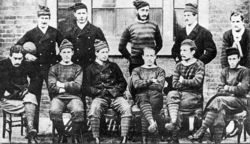
On July 20, 1871, C. W. Alcock suggested that "a Challenge Cup should be established" for The Football Association. This idea led to the creation of the FA Cup. In the first FA Cup final in 1872, Wanderers played against Royal Engineers. About 2,000 people paid to watch. The Royal Engineers were expected to win, but one of their players broke his collarbone early in the game. Since substitutions were not allowed yet, the Engineers played with one less player for the rest of the match. They eventually lost 1–0.
The success of this first FA Cup made many English clubs want to join. To play, they had to use The FA's new rules. This helped spread a single set of rules quickly. These rules are the foundation for all association football rules today.
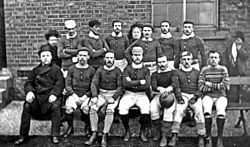
Later FA Cup competitions were often won by teams from the South of England, often made up of "Gentlemen" (amateur players). These included Old Etonians, Wanderers, Royal Engineers, and Oxford University, who together won 19 titles. Queens Park from Scotland had to withdraw from the 1873 semi-finals because they couldn't afford to travel to England often. This directly led to the creation of the Scottish FA. However, Queens Park still played in the FA Cup, reaching the final twice, until the Scottish FA banned Scottish clubs from entering in 1887.
In 1872, C. W. Alcock bought the FA Cup trophy for £20. Fifteen clubs entered the competition that year. Wanderers won the cup outright in 1878 after winning it three times in a row. They returned the cup to The FA so the competition could continue, on the condition that no other club could win the cup outright ever again.
The First League
In 1888, William McGregor, a director of Aston Villa F.C., helped organize meetings in London and Manchester. These meetings involved 12 football clubs who wanted to create a league competition. These 12 clubs became the first members of the Football League. The main reason for forming a league was that in the FA Cup, if a team lost early, they might not have any matches for almost a year. This meant they could lose a lot of money, and fans might stop supporting them. The league guaranteed games for all its member clubs.
McGregor voted against the name "The Football League" because he was worried it sounded too much like the Irish Land League. But the name still won by a majority vote. The league was split equally between teams from the North and Midlands of England. It did not include Southern teams, who were still strictly amateur.
A rival English league, the Football Alliance, ran from 1889 to 1892. In 1892, the two leagues decided to merge. This created the Football League Second Division, mostly made up of Football Alliance clubs. The existing League clubs, plus three strong Alliance clubs, formed the Football League First Division.
The First International Match
The first international football game was played in Scotland on November 30, 1872. Charles Alcock, who was The FA's secretary, came up with the idea of an annual match between Scotland and England. In 1870 and 1871, he asked for Scottish players to join an international match. The only responses he got were from Scots living in England. So, the 1870 and 1871 matches were played by Scots living in England. Alcock insisted these matches were "open to every Scotsman."
In 1872, Queens Park FC from Scotland finally accepted the challenge. The first international match officially recognized by FIFA took place on November 30, 1872, in Glasgow, Scotland. It ended in a 0–0 draw. This match started one of the most famous rivalries in football history. The second game between the two sides, on March 8, 1873, ended 4–2 for England. The Scots then won the next game 2–1.
The first international match outside Europe was played on November 28, 1885, in Newark, New Jersey, between the US and Canada. Canada won 1–0.
From Amateurs to Professionals
When football became more popular in the 1870s and 1880s, professional players were not allowed in England and Scotland. But in the 1880s, especially in the North of England, teams started hiring players known as 'professors of football'. These were often professional players from Scotland. This was the first time players were paid to play football. Clubs in working-class areas, especially in Northern England and Scotland, wanted professional football so players could afford to play while also working. Several clubs were accused of paying their players.
The northern clubs, with their paid players, started to become stronger than the amateur "Gentleman Southerners." The first northern club to reach the FA Cup final was Blackburn Rovers in 1882. They lost to Old Etonians, who were the last amateur team to win the trophy.
In the summer of 1885, there was pressure on the Football Association to allow professional players in English football. This led to a special meeting on July 20. After the meeting, it was announced that it was "in the interests of Association Football, to legalise the employment of professional football players, but only under certain restrictions." Clubs were allowed to pay players if they were born or had lived for two years within six miles of the club's ground. There were also rules to stop professional players from playing for more than one club in a season without special permission. All professional players had to be registered with The FA.
Even though English clubs hired professionals, the Scottish Football Association still banned it. Because of this, many Scottish players moved south to England. The FA first tried to limit this with residency rules, but these were removed by 1889. In the first season of the Football League (1888–89), the champions, Preston North End, had ten Scottish professional players.
One team that benefited from Scottish players, nicknamed the Scotch Professors, was Sunderland A.F.C.. The club became professional in 1885 and hired many Scotsmen that same year. The club's founder, James Allan, left Sunderland in 1888 because he didn't like the "professionalism" that was growing in the club.
The Scottish FA finally allowed professionalism in 1893. Soon after, 560 players were registered as professionals.
Early English women's teams, like the Dick, Kerr's Ladies from Preston, were very popular. Their matches even raised money for charities. The first recorded women's football match was on March 23, 1895, in England, between a northern and southern team. These fundraising matches continued, even though some people objected. In 1921, women were banned from playing on FA league grounds. The FA's history says this ban "effectively destroyed the game" for women in England for the next 40 years.
Football During Wartime
Between 1915 and 1919, official football competitions were stopped in England because of World War I. Many footballers joined the war effort, so many teams had fewer players. Regional league competitions were set up instead. Games played in these tournaments do not count in players' official records.
Football Spreads Around the World
Europe
The oldest football club in mainland Europe might be the Swiss club Lausanne Football and Cricket Club, founded in 1860. Football was introduced in a Belgian school in Melle (near Ghent) in 1863. In the Netherlands, the first football match was played in 1865 in Enschede. This led to the founding of Koninklijke HFC in 1879, the first Dutch football club. Ten years later, in 1889, the Royal Dutch Football Association (the KNVB) was founded.
Association football was introduced to the Danish club Kjøbenhavns Boldklub (KB) by English residents. It also came to the Swiss club FC St. Gallen in 1879 and to the Belgian club Royal Antwerp FC in 1880. This makes KB, St. Gallen, Koninklijke HFC, and Royal Antwerp FC some of the oldest football clubs still playing in Europe. Royal Antwerp FC is special because it has never merged with another club.
The Danish Football Association was founded in 1889. Italian football was played in regional groups from its start in 1898 until 1929. That's when the Serie A was organized into a national league by the Italian Football Federation. La Liga, Spain's national league, had its first season in 1928. Its teams were based on previous winners of the Copa del Rey, which began in 1902. The modern German national league, the Bundesliga, was founded quite late for a European country, not until 1963. The German Football Association was founded much earlier, in 1900, with Leipzig becoming the first German football champions in 1903. Before the Bundesliga, German football was played at an amateur level in many regional leagues.
South America
The first recorded football match in Argentina was played in 1867 by British railway workers. The game was a mix of association football and rugby, allowing players to use their hands. The first association football team in South America, Buenos Aires Football Club, was created in Argentina that same year. The country's first league, the "Association of Argentine Football" (AAF), was founded in 1891. This league organized the first championship in 1891, making Argentina's the oldest association football league outside Great Britain. Its successor, the Argentine Football Association, was founded by Scottish schoolteacher Alexander Watson Hutton in 1893 and still exists today.
In the 1870s, an expatriate named John Miller, who worked on a railway project in São Paulo, Brazil, sent his young son Charles William Miller to England for his education. In 1884, Charles, at age 10, went to Bannister's school in Southampton. Charles was a natural footballer who quickly learned the game. He played for the Southampton Club team and then for the County team of Hampshire.
When he returned to Brazil, Miller brought some football equipment and a rule book with him. He then helped develop the new rules of the game among the community in São Paulo. In 1888, the first sports club in the city, São Paulo Athletic Club, was founded. São Paulo Athletic Club won the first three years of championships. Charles Miller's skills were much better than his teammates at this time. He even had a move named after him, a clever flick of the ball with the heel called "Chaleira."
Charles Miller kept a strong connection with English football throughout his life. Teams from Southampton and Corinthians Club came to Brazil and played against São Paulo Athletic Club and other teams. In 1910, a new local team was about to be formed after a tour by the Corinthians team to Brazil. Charles was asked to suggest a name for the team, and he suggested they call themselves after Corinthians.
In the early 1900s, several British clubs toured South America, mainly Argentina, Uruguay, and Brazil. Southampton was the first foreign club to tour the continent in 1904. These tours helped spread and develop football in the region. Some matches, like the one between Alumni and South Africa, were watched by more than 10,000 people. These British team trips continued until 1929.
The Argentine Primera División is the oldest league in South America, first held in 1891. Argentina was the first country outside the United Kingdom to create a football league. The Uruguayan Football Association was also established in 1900. Both associations organized the first "Rioplatense" club competitions in the region, starting with the Tie Cup in 1900.
United States
The first association football club in the United States was the Oneida Football Club of Boston, Massachusetts, founded in 1862. It is often said that this was the first club to play association football outside Britain. However, the Oneidas were formed before the English Football Association (FA). It's not known exactly what rules they used, and the club closed down within a few years.
The first U.S. match known to be inspired by FA rules was a game between Princeton and Rutgers in 1869. However, this game still had features like very physical tackling and teams of 20 players. Other colleges copied this, but by the mid-1870s, all these games changed to rugby-oriented rules. These games would soon become famous as early versions of American football.
Early football leagues in the U.S. mostly used the name "football leagues." For example, the American Football Association (founded in 1884) and the American League of Professional Football (1894). However, the word "soccer" started to become popular. The St. Louis Soccer League was an important regional competition between 1907 and 1939. What is now the United States Soccer Federation was originally the U.S. Football Association, formed in 1913. The governing body of the sport in the U.S. didn't have the word "soccer" in its name until 1945, when it became the U.S. Soccer Football Association. It didn't drop the word "football" from its name until 1974, when it became the U.S. Soccer Federation.
Two more football leagues started in 1967: the United Soccer Association and the National Professional Soccer League. These merged to form the North American Soccer League in 1968, which lasted until 1984. The highest level of association football in the United States today is Major League Soccer, which was formed because the U.S. hosted the 1994 FIFA World Cup.
The Creation of FIFA
As international football matches became more popular in the early 1900s, there was a clear need for one main organization to oversee the game worldwide. The English Football Association had talked about setting up an international body but didn't make much progress. So, seven other European countries came together to form this association. FIFA (Fédération Internationale de Football Association) was founded in Paris on May 21, 1904. Its French name and acronym are still used today, even in non-French-speaking countries. Its first president was Robert Guérin.
FIFA held its first international competition in 1906, but it wasn't very successful. Because of this and other money issues, Guérin was quickly replaced by Daniel Burley Woolfall from England, which had joined FIFA by then. The next tournament, the football competition for the 1908 Olympics in London, was more successful.
FIFA's membership grew beyond Europe when South Africa joined in 1909, Argentina in 1912, and the United States in 1913.
FIFA struggled during World War I because many players went to war, and it was hard to travel for international matches. After the war, the organization was saved from closing down. However, the "Home Nations" (England, Scotland, Wales, and Northern Ireland) withdrew. They said they didn't want to play in international competitions with countries they had recently fought against in the war.
In 1946, the four British nations returned to FIFA. On May 10, 1947, a famous 'Match of the Century' was played between Great Britain and a 'Rest of Europe XI' team at Hampden Park in Glasgow. 135,000 spectators watched Britain win 6–1. The money from the match, £35,000, was given to FIFA to help restart it after World War Two. This was followed by FIFA's first post-war World Cup in 1950, held in Brazil. FIFA continued to grow, and by its fiftieth anniversary, it had 84 members.
The FIFA World Cup
The first men's football World Cup was played in Uruguay in 1930. In the first championship match between Argentina and Uruguay, the teams couldn't agree on which ball to use. So, they used Argentina's ball in the first half and Uruguay's in the second. Many countries did not enter, but most of those that did came from the Americas. By 1950, European teams became interested, and the competition grew into the world's biggest football and sporting event.
The South American Copa América was first played in 1916, before the World Cup. Decades later, other continental championships started. These include the AFC Asian Cup (1956), the African Cup of Nations (1957), the European Championship (1960), North America's Gold Cup (1991), and Oceania's OFC Nations Cup (1996).
Brazil is the most successful team in the World Cup, having won five times. The next most successful teams are Italy and Germany (including wins as West Germany) with four titles each. Argentina has won three titles. Uruguay and France each have two titles.
The FIFA Women's World Cup
The FIFA Women's World Cup started with the 1991 FIFA Women's World Cup, hosted in China. Twelve teams represented their countries.
Over 90,185 spectators attended the 1999 FIFA Women's World Cup, and nearly 1 billion viewers from 70 countries watched. By the 2003 FIFA Women's World Cup, 16 teams competed in the championship finals. As of 2019, the United States is the most successful team with four titles (1991, 1999, 2015, 2019). Germany has won twice (2003, 2007), and Norway (1995) and Japan (2011) have each won once. Women's football has the same continental groups as men's football.
See also
 In Spanish: Historia del fútbol para niños
In Spanish: Historia del fútbol para niños
- History of football in England
- British football clubs tours to South America
- Timeline of association football


